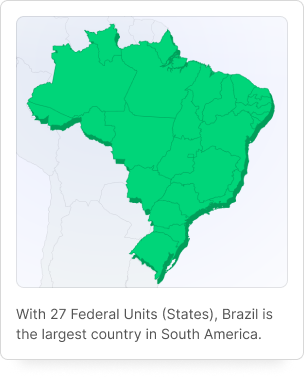Mato Grosso
- Distrito Federal (DF)
- Goiás (GO)
- Mato Grosso do Sul (MS)
Mato Grosso is historically known for its agricultural production and has experienced significant economic growth due to its robust agro-industry. The state's economic landscape is diversified, encompassing not only agriculture but also sectors like mining and renewable energy. Infrastructure development has been a diferential, enhancing connectivity and creating favorable conditions for increased investment in innovation.
- HDI: 0.736 - High
- Population: 3,658,649 (est)
- Total Area: 903,208 km2
- Roadways: 37,225km
State’s highlights:
Large mineral reserves with high potential for exploration;
Renewable energy generation expansion, with solar power plants, wind farms and biomass plants present throughout the state;
Biofuel production focused on corn ethanol – 80% of the national production;
Largest Brazilian cattle herd, as well as a leader producer of soybeans, corn, cotton and beef.
Demographics and Geography
Mato Grosso, with an expansive land area of approximately 903,206 square kilometers, is the third-largest state in Brazil and the 17th most populous. The state capital, Cuiabá, serves as the political, cultural, and economic center. Mato Grosso's population, which numbered around 3.66 million people in 2022, is characterized by a diverse mix of ethnicities, primarily consisting of Europeans, Indigenous peoples, and Afro-Brazilians. Experiencing a growth rate of 2.5% annually, the population surge is fueled by economic expansion and internal migration.
The state is in the Center-West region of Brazil and borders the states of Amazonas, Pará, Tocantins, Goiás, Mato Grosso do Sul and Bolivia. The terrain of Mato Grosso is predominantly flat, with altitudes ranging from 200 to 500 meters above sea level. The state is intersected by a series of rivers, including the Paraguay River, the Araguaia River, and the Xingu River, forming a crucial water reserve. These rivers collectively create the Pantanal, the world's largest flooded plain.
Economy
Mato Grosso is renowned for its robust agricultural and agribusiness sector. The state is a major producer of soybeans, corn, cotton, and beef, making it a major contributor to Brazil's agricultural output. The state's fertile land and favorable climate conditions have contributed to its reputation as a global agricultural powerhouse, which contributed to the attraction of US$20 million in foreign investment in 2022, according to the state’s government.
The mineral sector in Mato Grosso has great potential for growth. The state produces in only 0.5% of its territory and is the sixth largest mineral producer in Brazil, with large reserves of gold, limestone, manganese, mineral water, tin, diamond, construction aggregates (sand, gravel), and zinc. The sector accounted for approximately 4.2% of the state's GDP in 2021, according to the Matogrossense Mining Company - METAMAT. Notably, about 80% of the state’s production is comprised of gold and limestone.
Moreover, Mato Grosso is exploring its potential in renewable energy, including wind and solar power, to address the growing demand for clean energy sources. The state has a vast expanse of flat lands with good exposure to sunlight and winds. The government has adopted a series of initiatives to promote the development of the industry, including the creation of fiscal incentives, the organization of energy auctions for the contracting of renewable energy projects, and support for research and development. According to the National Electric Energy Agency (ANEEL), by 2022, the state already had several renewable energy projects in operation, including 100 solar power plants, 20 wind farms, and approximately 20 biomass plants.
The government of Mato Grosso estimates that the state could generate around 10,000 megawatts of renewable energy by 2030. A notable development is the announcement by Brasol, which is 49% owned by Siemens, in partnership with Grupo Oeste and Enersim, to implement 45 photovoltaic solar farms by early 2024, with a total investment of R$250 million.
In 2022, Mato Grosso's industry experienced robust growth, registering a notable increase of 19.4%, surpassing the national average. This significant expansion, as reported by the Industry Observatory of the Federation of Industries of Mato Grosso (FIEMT), was primarily propelled by the thriving agro-industry. The sectors contributing notably to this growth were biofuel production and food manufacturing, highlighting the region's leadership role in these segments.
At present, the state holds the distinction of being the foremost producer of corn ethanol in Brazil, contributing approximately to 80% of the country's overall production, as reported by the National Corn Ethanol Union. Mato Grosso hosts a significant majority of operational corn ethanol plants in the country, with 11 out of the 18 plants. Furthermore, ongoing efforts to expand this sector are evident, with the installation of six new units already underway. Projections indicate that the number of corn ethanol plants in the state is expected to increase to 19 in the coming years.
In 2022, Mato Grosso reaffirmed its position as the leading producer of soybeans, corn, and cotton in the country, boasting a substantial 30.2% share. The state continues to play a significant role in Brazil's agricultural landscape, concentrating over one-fifth of the national agricultural production value. Additionally, Mato Grosso is renowned for maintaining the largest Brazilian cattle herd with 34.4 million heads, relying in small and medium-sized producers. Annually, the state provides sustenance to 20 million people globally and within Brazil. This agricultural prominence extends to the meat industry, as evidenced by beef exports reaching US$3 billion in 2022, solidifying the state's position as the foremost exporter of red meat in the country.
According to a study published by the Mato Grosso Institute of Agricultural Economics, 60.6% of the state's territory is occupied by indigenous lands (15.4%), conservation units (4.5%) and areas preserved by agricultural producers (40.7%). The exponential growth in the state's production in recent years compared to the figures for environmental conservation and preservation shows that Mato Grosso has been producing more without widely expanding the area under cultivation.
The state has established the Sustainable Municipalities Program in Mato Grosso, known as PMS. The goal is to advance the sustainable development of municipalities in the region. This involves bolstering the local economy, enhancing municipal governance, ensuring legal security, conserving natural resources, undertaking environmental restoration efforts, and mitigating social inequalities.
The Competitiveness Ranking of the States for 2023, published by the Center for Public Leadership, places Mato Grosso in the eighth position compared to other states, with excellent results in Fiscal Solvency (1st position), Efficiency of Public Administration (6), Infrastructure, Market Potential, Human Capital, and Social Sustainability all ranking eighth.
In the World Bank's Subnational Doing Business in Brazil 2021, Mato Grosso ranks in 19th. The state shows good performance in Enforcing Contracts, Registering Property and Dealing with construction permits.
Infrastructure
In addition to agriculture, Mato Grosso is gaining prominence in the transportation and logistics industry due to its strategic geographic location and extensive river and road networks. The state's rivers, including the Paraguay and Amazon, enable efficient trade and export routes, while highways connect it to major Brazilian cities.
Mato Grosso has an extensive network of waterways, especially the Paraguay River, which is one of the state's main cargo transportation routes. The Paraguay River is navigable by large vessels all the way to the city of Cáceres, some 700 kilometers from the mouth of the river, on the border with Paraguay. Waterways are used to transport soybeans, corn, cotton, wood and other products.
Railroads
Mato Grosso has a rail network of around 1,000 kilometers, which is mainly used for transporting grain. The state's main railroad is the North-South Railway, which connects the port of Santos, in São Paulo, to the city of Porto Velho, in Rondônia, crossing Mato Grosso from east to west.
The North-South railroad is being expanded to meet the growing demand for grain transportation in Mato Grosso. The expansion should make it easier to transport the state's agricultural production and reduce transportation costs. Once completed, the railroad will cross 16 municipalities in the state, have 22 bridges, 21 viaducts, 2 kilometers of tunnels and 11.5 kilometers of bridges.
The first part of the project, which began in November 2022, will cover around 210 km, from Rondonópolis to Campo Verde, both in the south of Mato Grosso. In this phase, the planned investment is between R$4 billion and R$4.5 billion, and completion is expected by the end of 2025. The railroad is expected to arrive in Campo Verde at the end of 2025 (first terminal), then move on to the Cuiabá branch and continue the extension to Nova Mutum, with arrival expected in 2028. In the north of Mato Grosso, in Lucas do Rio Verde, it is expected to arrive in 2030, at the end of the entire project.
Highways
Mato Grosso's road network is around 100,000 kilometers long and is the state's main transport route. The Mato Grosso government has invested in improving the quality of the state's highways. These improvements have reduced the cost of transportation and made it easier to transport the state's agricultural production.
BR-163
BR-163 is Mato Grosso's main highway and the most important grain transportation route in the state. The highway connects the port of Santos, in São Paulo, to the city of Cuiabá, in Mato Grosso. It is used to transport soybeans, corn, cotton and other grains. The highway is responsible for transporting around 80% of Mato Grosso's agricultural production.
BR-364
The highway connects the city of Cuiabá to the city of Porto Velho, in Rondônia. BR-364 is used to transport soy, corn, cotton and other grains. The highway is responsible for transporting around 20% of Mato Grosso's agricultural production.
BR-070
BR-070 connects the city of Cuiabá to the city of Brasília, in the Federal District. The highway is used for the transportation of people, goods and services.
MT-010
MT-010 connects the city of Cuiabá, in the south of the state, to the city of Sinop, in the north of Mato Grosso. The highway is used for the transportation of people, goods and services.
Airports
Mato Grosso has 26 airports, 11 of which have paved runways. The state's main airport is Cuiabá International Airport, which receives flights from several airlines.
Innovation
The innovation ecosystem in Mato Grosso is relatively new but has been growing in recent years. The state holds significant potential for innovation, boasting a robust agricultural sector, a young and qualified population, and a government that invests in innovation.
According to the Innovation Ecosystem Map of Mato Grosso, produced by the State Department of Economic Development (Sedec), the current estimated number of startups in the state is around 300. The primary areas of focus for these startups include agriculture, information and communication technologies (ICT), and renewable energy.
In the agricultural sector, noteworthy solutions include precision agriculture, sustainable farming, and biotechnology. In the field of ICT, startups are engaged in cloud computing, artificial intelligence, and cybersecurity. Finally, within the realm of renewable energy, startups predominantly focus on solutions for energy generation, storage, and distribution.
The government of Mato Grosso has implemented various public policies and incentives to promote innovation in the state. Some of the most important public policies include:
Innovation Law of Mato Grosso: This law provides fiscal incentives for companies investing in Research, Development, and Innovation (RD&I) in the sectors of agriculture, information and communication technologies, and renewable energy.
Centelha Program: The Centelha Program is an innovation promotion initiative that provides financial resources to early-stage startups. The program is conducted by the Ministry of Science, Technology, and Innovations (MCTI) in collaboration with states and municipalities. In Mato Grosso, the Centelha Program has already benefited over 100 startups. Selected startups receive financial resources of up to R$ 50,000, along with mentorship and training.
Mato Grosso Technological Park: Inaugurated in 2022, this park offers infrastructure and services for companies, startups, and research institutions, further supporting the growth of the innovation ecosystem in the state.
About Brazil
Brazil is a federation composed of 26 states, one federal district, and the 5,570 municipalities. Learn more about what each region can offer:
Brazil's diversified economy includes agriculture, industry, and a wide range of services.[259] The large service sector accounts for about 72.7% of total GDP, followed by the industrial sector (20.7%), while the agriculture sector is by far the smallest, making up 6.6% of total GDP.[260]

Regions

North Region
With seven states, the region is dominated by the Amazon Rainforest, the largest tropical rainforest in the world. The economy is influenced by agriculture, forestry and mining, with the sustainable management of natural resources at the center of public policies.

Northeast Region
The region presents a lengthy coastline along its nine states. Although agriculture has been a traditional economic driver, renewable energy, petrochemicals and innovation have seen a significant growth in recent years, changing the region's vocation.

Central-West Region
Only three states and a Federal District make it the agricultural heartland of Brazil. It is also home to a diverse array of wildlife and ecosystems, including parts of the Amazon rainforest and the Pantanal, the world's largest tropical wetland area. Brasília, the country's capital, is an important hub in the region.

Southeast Region
Marked by its dynamic urban centers, the region drives Brazil's innovation, commerce and industrialization. Comprising four states, it is home to the country's financial capital, São Paulo, which is also Latin America's economic center and one of the major global cities.

South Region
The region stands out as a well-developed portion of Brazil. It has a strong economic performance supported by a highly productive agriculture and a skilled industry, which reflects in the region's high standard of living, efficient infrastructure and economic stability.

